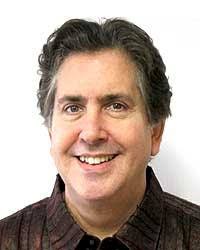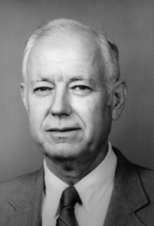Planner is a programming language designed by Carl Hewitt at MIT, and first published in 1969. First, subsets such as Micro-Planner and Pico-Planner were implemented, and then essentially the whole language was implemented as Popler by Julian Davies at the University of Edinburgh in the POP-2 programming language. Derivations such as QA4, Conniver, QLISP and Ether were important tools in artificial intelligence research in the 1970s, which influenced commercial developments such as Knowledge Engineering Environment (KEE) and Automated Reasoning Tool (ART).

Douglas Bruce Lenat was an American computer scientist and researcher in artificial intelligence who was the founder and CEO of Cycorp, Inc. in Austin, Texas.
The Automated Mathematician (AM) is one of the earliest successful discovery systems. It was created by Douglas Lenat in Lisp, and in 1977 led to Lenat being awarded the IJCAI Computers and Thought Award.

John McCarthy was an American computer scientist and cognitive scientist. He was one of the founders of the discipline of artificial intelligence. He co-authored the document that coined the term "artificial intelligence" (AI), developed the programming language family Lisp, significantly influenced the design of the language ALGOL, popularized time-sharing, and invented garbage collection.
In artificial intelligence, symbolic artificial intelligence is the term for the collection of all methods in artificial intelligence research that are based on high-level symbolic (human-readable) representations of problems, logic and search. Symbolic AI used tools such as logic programming, production rules, semantic nets and frames, and it developed applications such as knowledge-based systems, symbolic mathematics, automated theorem provers, ontologies, the semantic web, and automated planning and scheduling systems. The Symbolic AI paradigm led to seminal ideas in search, symbolic programming languages, agents, multi-agent systems, the semantic web, and the strengths and limitations of formal knowledge and reasoning systems.
A blackboard system is an artificial intelligence approach based on the blackboard architectural model, where a common knowledge base, the "blackboard", is iteratively updated by a diverse group of specialist knowledge sources, starting with a problem specification and ending with a solution. Each knowledge source updates the blackboard with a partial solution when its internal constraints match the blackboard state. In this way, the specialists work together to solve the problem. The blackboard model was originally designed as a way to handle complex, ill-defined problems, where the solution is the sum of its parts.
In artificial intelligence research, commonsense knowledge consists of facts about the everyday world, such as "Lemons are sour", or "Cows say moo", that all humans are expected to know. It is currently an unsolved problem in Artificial General Intelligence. The first AI program to address common sense knowledge was Advice Taker in 1959 by John McCarthy.
In computer science, in particular in knowledge representation and reasoning and metalogic, the area of automated reasoning is dedicated to understanding different aspects of reasoning. The study of automated reasoning helps produce computer programs that allow computers to reason completely, or nearly completely, automatically. Although automated reasoning is considered a sub-field of artificial intelligence, it also has connections with theoretical computer science and philosophy.

Alan Richard Bundy is a professor at the School of Informatics at the University of Edinburgh, known for his contributions to automated reasoning, especially to proof planning, the use of meta-level reasoning to guide proof search.

Alexander L'vovich Brudno was a Russian computer scientist, best known for fully describing the alpha-beta pruning algorithm. From 1991 until his death he lived in Israel.
Richard Jay Waldinger is a computer science researcher at SRI International's Artificial Intelligence Center whose interests focus on the application of automated deductive reasoning to problems in software engineering and artificial intelligence.
David Alan Plaisted is a computer science professor at the University of North Carolina at Chapel Hill.

Carl Eddie Hewitt was an American computer scientist who designed the Planner programming language for automated planning and the actor model of concurrent computation, which have been influential in the development of logic, functional and object-oriented programming. Planner was the first programming language based on procedural plans invoked using pattern-directed invocation from assertions and goals. The actor model influenced the development of the Scheme programming language, the π-calculus, and served as an inspiration for several other programming languages.

Eric Joel Horvitz is an American computer scientist, and Technical Fellow at Microsoft, where he serves as the company's first Chief Scientific Officer. He was previously the director of Microsoft Research Labs, including research centers in Redmond, WA, Cambridge, MA, New York, NY, Montreal, Canada, Cambridge, UK, and Bangalore, India.
Donald W. Loveland is a professor emeritus of computer science at Duke University who specializes in artificial intelligence. He is well known for the Davis–Putnam–Logemann–Loveland algorithm.
Herbert Leo Gelernter was a professor in the Computer Science Department of Stony Brook University.
Christoph Walther is a German computer scientist, known for his contributions to automated theorem proving. He is Professor emeritus at Darmstadt University of Technology.
James Robert Slagle was an American computer scientist notable for his many achievements in Artificial Intelligence. Since 1984 he has been the Distinguished Professor of Computer Science at the University of Minnesota, Minneapolis, with former appointments at Johns Hopkins University, the National Institutes of Health, the Naval Research Laboratory, Lawrence Livermore Radiation Laboratory, University of California, Berkeley, and the Massachusetts Institute of Technology.

Helen Chan Wolf is an artificial intelligence pioneer who worked on facial recognition technology and Shakey the robot, the world's first autonomous robot, at SRI International.
Deepak Kapur is a Distinguished Professor in the Department of Computer Science at the University of New Mexico.









